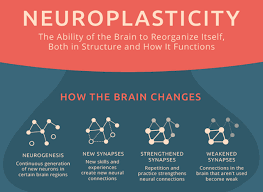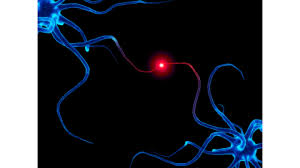Neuroplasticity- Restructuring the brain
“Every man can, if he so desires,can become the sculptor of his own brain”
-Santiago Ramon y Cajal.
INTRODUCTION
Neuroplasticity which is also known as brain plasticity is an umbrella term that describes lasting change to the brain throughout an individual’s life course. Yea you heard me right you can change or repair your brain, and you can even reorganize it, by forming new connections throughout life.

Image Credit
Neuroplasticity can be defined as brain’s ability to change, remodel and reorganize for purpose of better ability to adapt to new situations. Despite the fact that the concept of neuroplasticity is quite new, it is one of the most important discoveries in neuroscience. "The fact is that neural networks are not fixed, but occurring and disappearing dynamically throughout our whole life, depending on experiences. While we repeatedly practice one activity such as a sequence of movements or a mathematical problem, neuronal circuits are being formed, leading to better ability to perform the practiced task with less waste of energy. Once we stop practicing a certain activity, the brain will redirect these neuronal circuits by a much known ‘use it or lose it’ principle. Neuroplasticity leads to many different occurrences, such as habituation, sensitization to a certain position, medication tolerance, even recovery following brain injury.

Image Credit
The adult brain is much more changeable and modifiable than had previously been believed. There is now a large amount of evidence to show that damaged neural (brain) circuiting resulting from severe childhood trauma
History
120 years ago. William James suggested the theory or neuroplasticity in his work Principle of Psychology. He said that human brain is capable for continuous functional changes. Polish Neurologist Jerzy Konorski was the first to define the term neuroplasticity in 1948. He suggested a theory by which neurons which have been activated by closeness of an active neural circuit, change and incorporate themselves in to that circuit.
Now after learning what Neuroplasticity is, and where it originated from we will move to the Principle and Application of neuroplasticity.
Principle
Neuroplasticity is based on this simple principle that when a person learns a new skill, the brain forms new connection i.e. new circuits that can enable the person be efficient in that skill. New synaptic connections are being created and some are destroyed depending on the activity of the neurons carrying them, While we repeatedly practice one activity such as a sequence of movements or a mathematical problem, neuronal circuits are being formed, leading to better ability to perform the practiced task with less waste of energy. Once we stop practicing a certain activity, the brain will redirect these neuronal circuits by a much known ‘use it or lose it’ principle. There are also other principles that are also associated with neuroplasticity but for the case of this post it will be limited to the above but for further reading you can read This up.
Types of Neuroplasticity
Neuroplasticity is a general term, defining the fact that the brain changes, recognizing the need for further definition of the term. We distinguish structural from functional neuroplasticity.
• Structural neuroplasticity: Synaptic plasticity refers to changes in the strength between neurons (synapses), chemical or electric meeting points between brain cells. Synaptic plasticity is a general term, and the name itself has no meaning other that something changed within the synapse, but can include many specific processes such as long-term changes in the number of receptors for certain neurotransmitters, or changes where some proteins are being synthesized more within the cell. Synaptogenesis refers to formation and fitting of synapse or group of synapses into a neural circuit. Structural plasticity is a normal marking of fetal neurons during brain development and is called developmental plasticity, including neurogenesis and neuronal migration. Neuronal migration is a process in which neurons travel from their ‘place of birth’ in fetal ventricular or subventricular zone, towards their final position in the cortex.
.jpeg)
Image Credit
During development, brain areas become specialized for certain tasks such as processing signals from the surrounding areas through sensory receptors.
For example, in occipital brain area, the fourth layer of cortex hypertrophies in order to receive signals from the visual pathway. Neurogenesis is formation of new neurons. It is a process which mainly takes place during brain development, even though in the last decade neurogenesis was found in adult brain as well. On the other hand, neuronal death occurs throughout life, due to brain damage or programmed cell death. Other forms of structural neuroplasticity include changes in white or gray matter density which can be visualized by magnetic resonance.
• Functional neuroplasticity: Functional neuroplasticity depends upon two basic processes, learning and memory. They also represent a special type of neural and synaptic plasticity, based on certain types of synaptic plasticity causing permanent changes in synaptic effectiveness. During learning and memory permanent changes occur in synaptic relationships between neurons due to structural adjustments or intracellular biochemical processes.
Application of Neuroplasticity
There are various areas in which neuroplasticity can be applied namely:
• Brain Damage Treatment: Before 1980, it was widely accepted as fact in neuroscience that the central nervous system is hardwired and fixed. The very strong belief was that after an injury in adults, such as stroke or traumatic brain injury, the brain cannot repair itself. However, over the last 20 to 30 years persuasive evidence has been accumulating rapidly that the brain is plastic throughout a person’s lifespan; in effect, the adult brain can not only be rewired, it can also be structurally remodeled.
• Meditation: The mental training of mindfulness meditation is shown to be no different than other forms of skill acquisition that can induce neuroplasticity. Meditators may be strengthening the neural circuitry involved in the voluntary control of attention through repeated practice in focusing attention. The careful focus of attention through mindfulness meditation amplifies neuroplasticity by stimulating the release 12 of neurochemicals. These neurochemicals enhance the structural growth of synaptic linkages among the activated neurons. By practicing regular meditation, neural networks in the medial prefrontal cortex are strengthened and stabilized.
• Neuroplasticity plays a significant functional and ameliorative role across a wide spectrum of brain diseases as well as in normal ageing and health. Measures of plasticity can provide insights into disease pathogenesis, improve treatment strategies and help identify substrates of treatment effects.
With this little enlightenment I think we are no longer ignorant of what Neuroplasticity means…
In my next steemstem post I would be writing extensively on the Nervous system
Don’t Forget to Upvote, Comment and resteem….
References
Plasticity Of The Brain
Neuroplasticity
Harnessing Neuroplasticity for Clinical Applications
Neuroplasticity and Mindfulness Meditation
Hey @sammielaboi,
thank you for contributing a beautiful article to #air-curie.
We gave you an upvote!
Next time, use the #air-clinic tag.
Keep spreading health across the blockchain!
Nice 1
Thanks you...
Hope you read through??
What a nice write-up
Good write up
Very good post. Thanks :)
please use the quote function if you must copy a text from another source word for word. :)
Thanks boss..
you are welcome
Congratulations! This post has been upvoted from the communal account, @minnowsupport, by Sammielaboi from the Minnow Support Project. It's a witness project run by aggroed, ausbitbank, teamsteem, theprophet0, someguy123, neoxian, followbtcnews, and netuoso. The goal is to help Steemit grow by supporting Minnows. Please find us at the Peace, Abundance, and Liberty Network (PALnet) Discord Channel. It's a completely public and open space to all members of the Steemit community who voluntarily choose to be there.
If you would like to delegate to the Minnow Support Project you can do so by clicking on the following links: 50SP, 100SP, 250SP, 500SP, 1000SP, 5000SP.
Be sure to leave at least 50SP undelegated on your account.
This is quite informative and educating, l really enjoyed reading through. Please keep this good work up
Thank you very much...
@abuja-steem just upvoted this post. Help us to do more by upvoting this comment